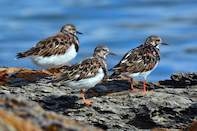
Ruddy Turnstone
Name
Ruddy Turnstone (Arenaria interpres)
Family
Scolopacidae
Length
23 cm
Appearance
The ruddy turnstone adult’s head and neck is a unique black-and-white pattern and the scapulars and wing-coverts are a bright chestnut. The head is mainly white with black streaks on the crown and a black pattern on the face.
The breast is mainly black apart from a white patch on the sides. The rest of the underparts are white. The pointed bill is black and the legs orange.
In summer, breeding birds have reddish-brown upper-parts with black markings. In winter plumage the adults have dark grey-brown upperparts with black mottling and a dark head with little white.
Ruddy Turnstone Call
When disturbed they fly away low over the water uttering their call of ‘kit-it-it-it’ or ‘chidda-chidda-chidda’.
Ruddy Turnstone Migration
The ruddy turnstone is a summer migrant from the Palaearctic (Europe, Asia north of the Himalayan foothills and northern Africa) found along the South African coast and on offshore islands.
Ruddy Turnstone Diet
The ruddy turnstone feeds mainly on invertebrates but the diet includes carrion, eggs, insects, crustaceans, molluscs, worms and plant material. It flips over stones and other objects to get at prey hiding underneath and this behaviour is the origin of the name “turnstone”.
Ruddy Turnstone Breeding
The species seen in South Africa breeds in the Arctic regions only.
Habitat
The ruddy turnstone frequents coastal mud-flats, shorelines and especially rocky shores. They are occasionally seen at inland waters.
Ruddy Turnstone Status
The ruddy turnstone is of least concern and a common summer visitor in South Africa.
Where they are found
The ruddy turnstone is commonly found at Langebaan in South Africa.
